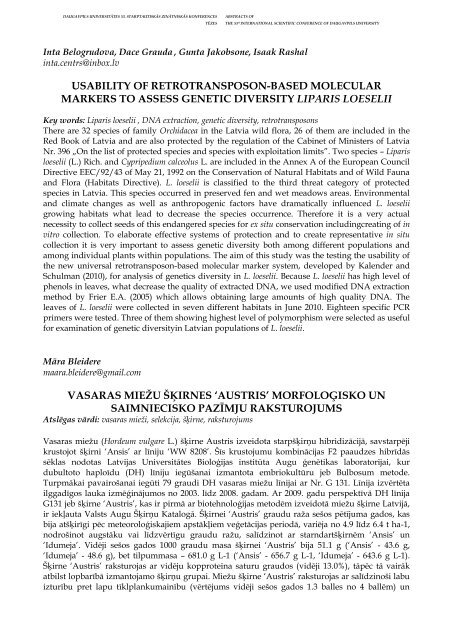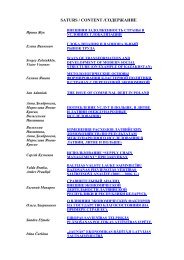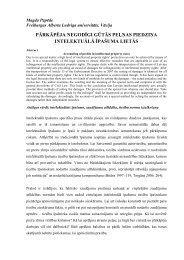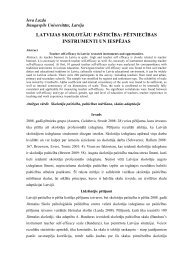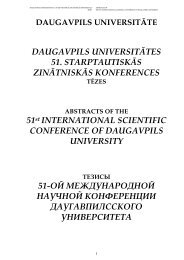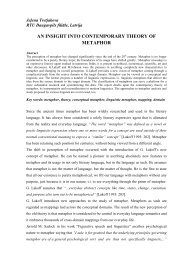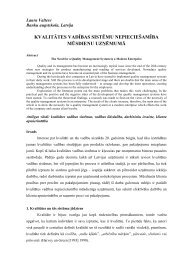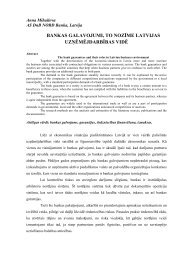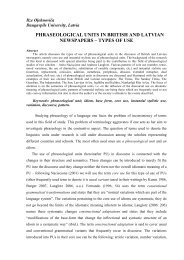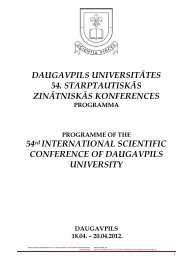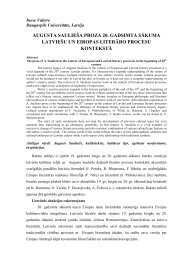OļehnoviÄs D., atbildÄ«gais par izd. / Resp. Ed ... - DU conference
OļehnoviÄs D., atbildÄ«gais par izd. / Resp. Ed ... - DU conference
OļehnoviÄs D., atbildÄ«gais par izd. / Resp. Ed ... - DU conference
You also want an ePaper? Increase the reach of your titles
YUMPU automatically turns print PDFs into web optimized ePapers that Google loves.
DAUGAVPILS UNIVERSITĀTES 53. STARPTAUTISKĀS ZINĀTNISKĀS KONFERENCES<br />
TĒZES<br />
ABSTRACTS OF<br />
THE 53 rd INTERNATIONAL SCIENTIFIC CONFERENCE OF DAUGAVPILS UNIVERSITY<br />
Inta Belogrudova, Dace Grauda , Gunta Jakobsone, Isaak Rashal<br />
inta.centrs@inbox.lv<br />
USABILITY OF RETROTRANSPOSON-BASED MOLECULAR<br />
MARKERS TO ASSESS GENETIC DIVERSITY LIPARIS LOESELII<br />
Key words: Li<strong>par</strong>is loeselii , DNA extraction, genetic diversity, retrotransposons<br />
There are 32 species of family Orchidacea in the Latvia wild flora, 26 of them are included in the<br />
Red Book of Latvia and are also protected by the regulation of the Cabinet of Ministers of Latvia<br />
Nr. 396 „On the list of protected species and species with exploitation limits‖. Two species – Li<strong>par</strong>is<br />
loeselii (L.) Rich. and Cypripedium calceolus L. are included in the Annex A of the European Council<br />
Directive EEC/92/43 of May 21, 1992 on the Conservation of Natural Habitats and of Wild Fauna<br />
and Flora (Habitats Directive). L. loeselii is classified to the third threat category of protected<br />
species in Latvia. This species occurred in preserved fen and wet meadows areas. Environmental<br />
and climate changes as well as anthropogenic factors have dramatically influenced L. loeselii<br />
growing habitats what lead to decrease the species occurrence. Therefore it is a very actual<br />
necessity to collect seeds of this endangered species for ex situ conservation includingcreating of in<br />
vitro collection. To elaborate effective systems of protection and to create representative in situ<br />
collection it is very important to assess genetic diversity both among different populations and<br />
among individual plants within populations. The aim of this study was the testing the usability of<br />
the new universal retrotransposon-based molecular marker system, developed by Kalender and<br />
Schulman (2010), for analysis of genetics diversity in L. loeselii. Because L. loeselii has high level of<br />
phenols in leaves, what decrease the quality of extracted DNA, we used modified DNA extraction<br />
method by Frier E.A. (2005) which allows obtaining large amounts of high quality DNA. The<br />
leaves of L. loeselii were collected in seven different habitats in June 2010. Eighteen specific PCR<br />
primers were tested. Three of them showing highest level of polymorphism were selected as useful<br />
for examination of genetic diversityin Latvian populations of L. loeselii.<br />
Māra Bleidere<br />
maara.bleidere@gmail.com<br />
VASARAS MIEŢU ŠĶIRNES ‘AUSTRIS’ MORFOLOĢISKO UN<br />
SAIMNIECISKO PAZĪMJU RAKSTUROJUMS<br />
Atslēgas vārdi: vasaras mieţi, selekcija, šķirne, raksturojums<br />
Vasaras mieţu (Hordeum vulgare L.) šķirne Austris izveidota starpšķirľu hibridizācijā, savstarpēji<br />
krustojot šķirni ‗Ansis‘ ar līniju ‗WW 8208‘. Šīs krustojumu kombinācijas F2 paaudzes hibrīdās<br />
sēklas nodotas Latvijas Universitātes Bioloģijas institūta Augu ģenētikas laboratorijai, kur<br />
dubultoto haploīdu (DH) līniju iegūšanai izmantota embriokultūru jeb Bulbosum metode.<br />
Turpmākai pavairošanai iegūti 79 graudi DH vasaras mieţu līnijai ar Nr. G 131. Līnija izvērtēta<br />
ilggadīgos lauka izmēģinājumos no 2003. līdz 2008. gadam. Ar 2009. gadu perspektīvā DH līnija<br />
G131 jeb šķirne ‗Austris‘, kas ir pirmā ar biotehnoloģijas metodēm izveidotā mieţu šķirne Latvijā,<br />
ir iekļauta Valsts Augu Šķirľu Katalogā. Šķirnei ‗Austris‘ graudu raţa sešos pētījuma gados, kas<br />
bija atšķirīgi pēc meteoroloģiskajiem apstākļiem veģetācijas periodā, variēja no 4.9 līdz 6.4 t ha-1,<br />
nodrošinot augstāku vai līdzvērtīgu graudu raţu, salīdzinot ar starndartšķirnēm ‗Ansis‘ un<br />
‗Idumeja‘. Vidēji sešos gados 1000 graudu masa šķirnei ‗Austris‘ bija 51.1 g (‗Ansis‘ - 43.6 g,<br />
‗Idumeja‘ - 48.6 g), bet tilpummasa – 681.0 g L-1 (‗Ansis‘ - 656.7 g L-1, ‗Idumeja‘ - 643.6 g L-1).<br />
Šķirne ‗Austris‘ raksturojas ar vidēju kopproteīna saturu graudos (vidēji 13.0%), tāpēc tā vairāk<br />
atbilst lopbarībā izmantojamo šķirľu grupai. Mieţu šķirne ‗Austris‘ raksturojas ar salīdzinoši labu<br />
izturību pret lapu tīklplankumainību (vērtējums vidēji sešos gados 1.3 balles no 4 ballēm) un


